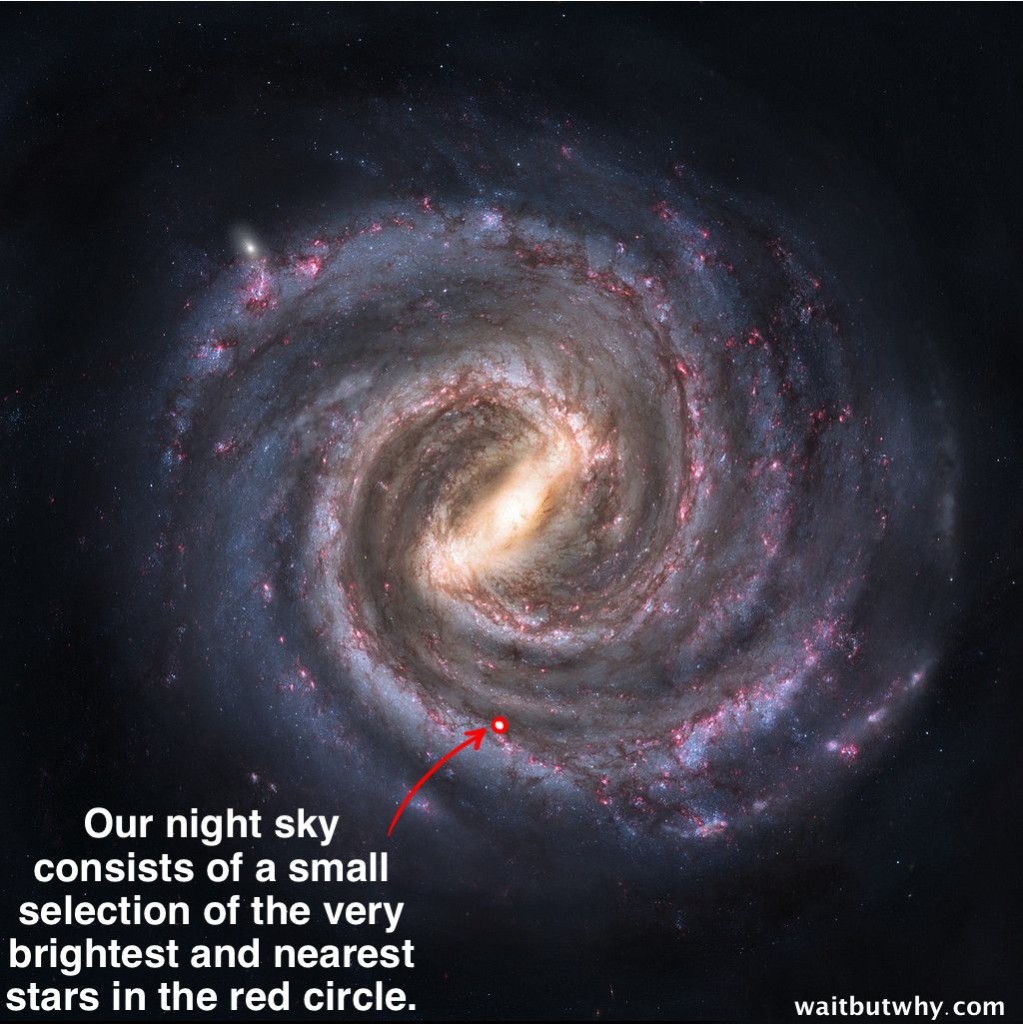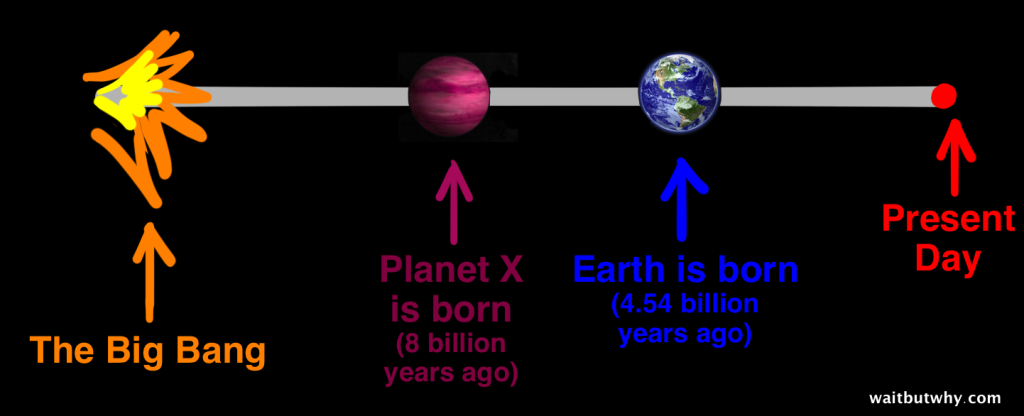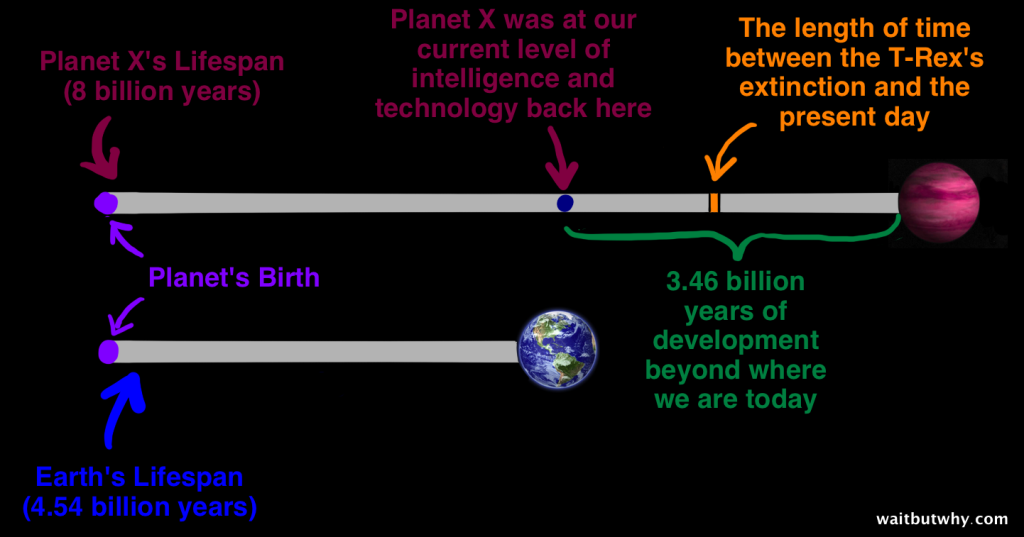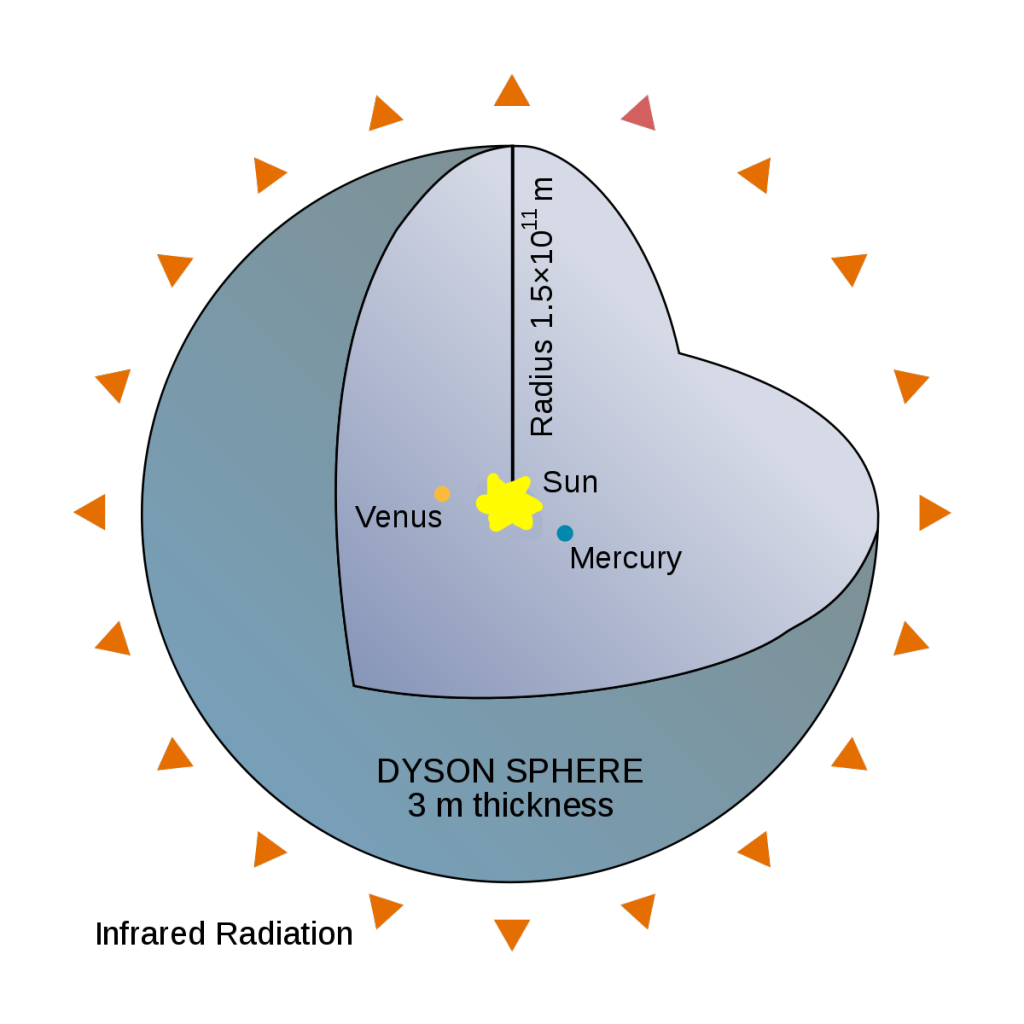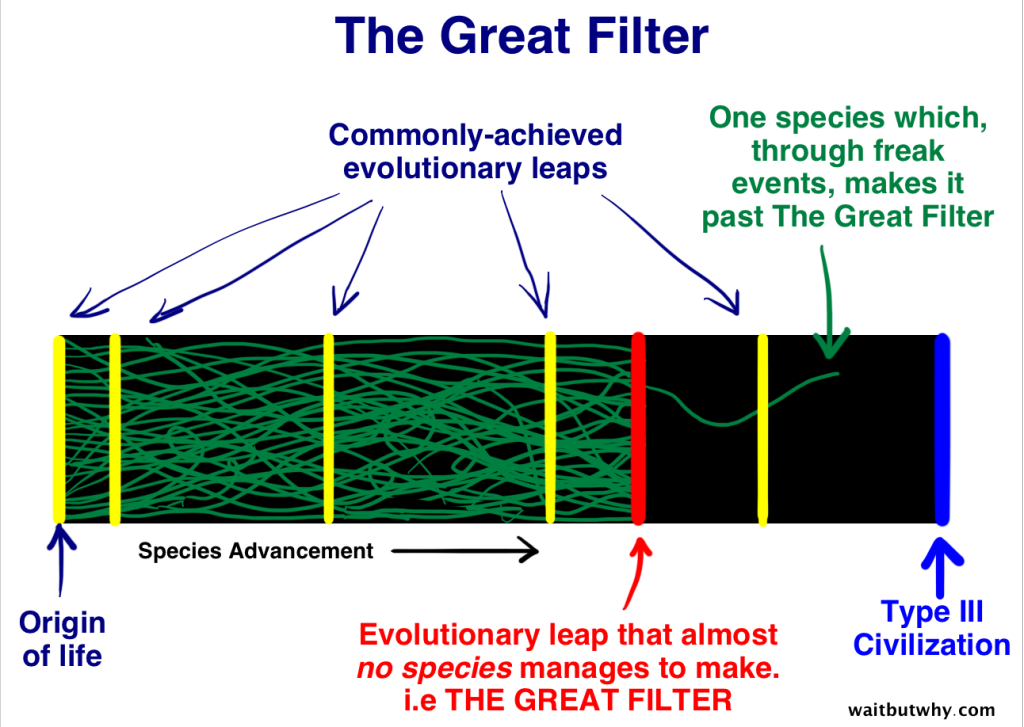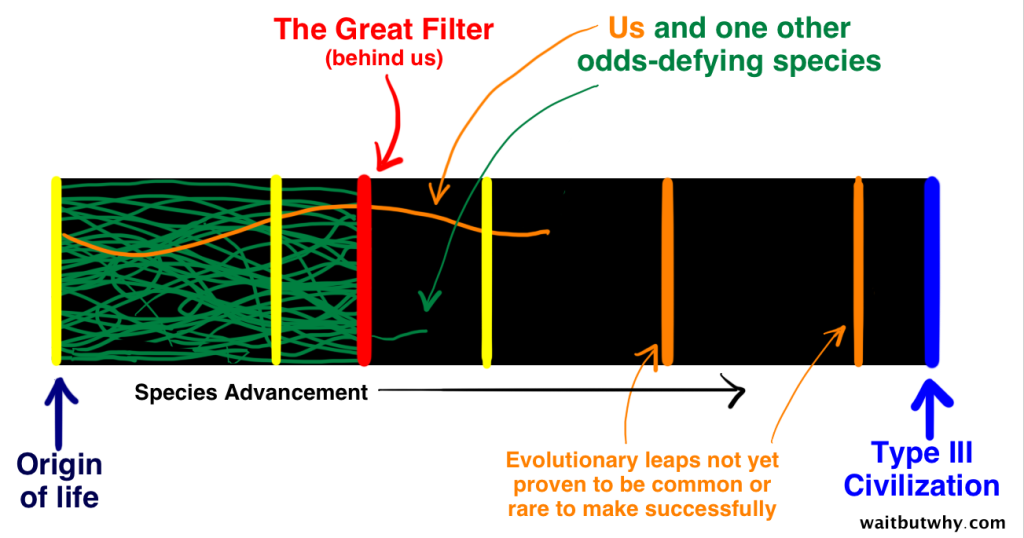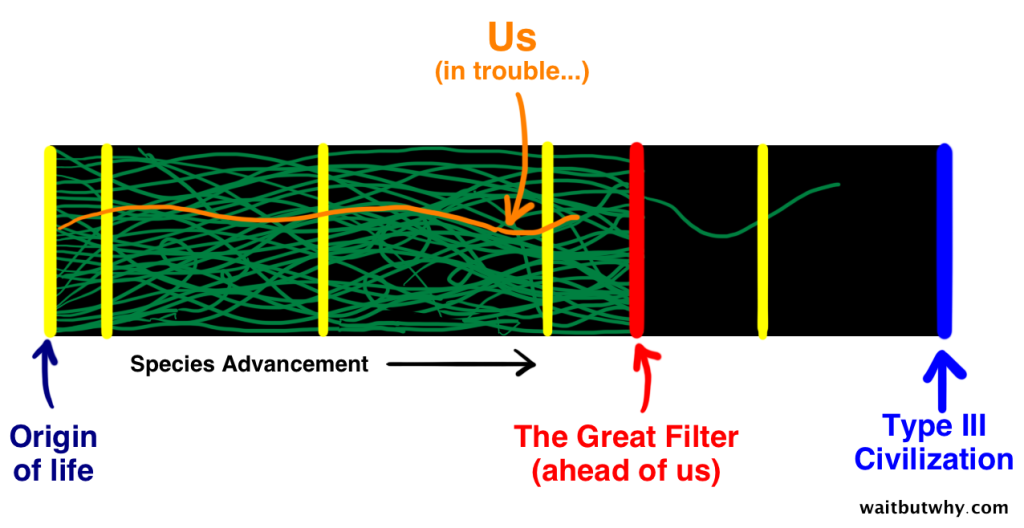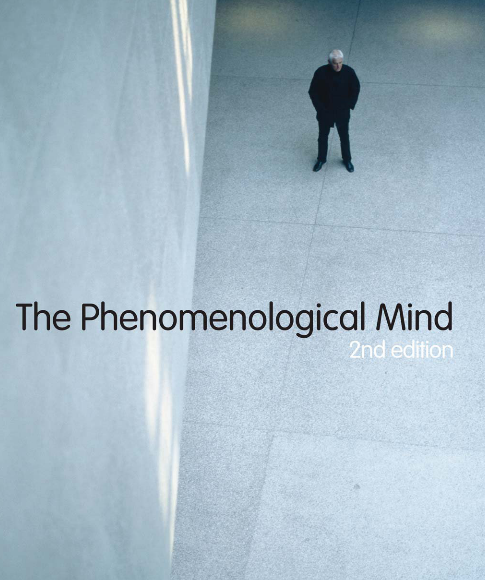 Google really spoiled developers attending its I/O conference yesterday by handing out pairs of cardboard VR specs. Missed out on bagging a pair? Never fear, watch this DIY how to video and you too can have your own ‘Oculus thrift’. Read More
Google really spoiled developers attending its I/O conference yesterday by handing out pairs of cardboard VR specs. Missed out on bagging a pair? Never fear, watch this DIY how to video and you too can have your own ‘Oculus thrift’. Read More
Shared posts
How To Make Your Own #Cardboard VR Goggles
 Google really spoiled developers attending its I/O conference yesterday by handing out pairs of cardboard VR specs. Missed out on bagging a pair? Never fear, watch this DIY how to video and you too can have your own ‘Oculus thrift’. Read More
Google really spoiled developers attending its I/O conference yesterday by handing out pairs of cardboard VR specs. Missed out on bagging a pair? Never fear, watch this DIY how to video and you too can have your own ‘Oculus thrift’. Read More
¡Qué bien! pero, ¿estará caducado? por @supermanumolina
José M MCEso para mi es kickstarter!
the star trek dilemma
José M MCodio eso!!!!
they do this on law and order too. “i think you’d better get over here, even though i’m basically committing you to a suspenseful 20-minute drive with no information”
new podcast today! if you haven’t heard of a show called “the zack files,” it’s because it never existed… until now.
Doing trial and error with chef
José M MCYo temo igual al aceite!

by DevopsMonkey
Fido Really Isn't Interested in Your Kale Lifestyle
SEGA Announces Sigourney Weaver & The Original Alien Cast Will Feature In Alien: Isolation Pre-Order Bonus Content - In space, no one can hear you squee.
José M MCNo lo voy a comprar. Se positivamente que jamás podré acabar este juego
 BRB, running around the room screaming.
BRB, running around the room screaming.
Hey, SEGA, I was already going to play this game but thanks for sucking up. We’ve previously expressed our excitement for Alien: Isolation, the game in which you get to play as Ellen Ripley’s daughter, Amanda, and fight xenomorphs just like dear old ma.
So are you ready for this? There are two, yes TWO, pre-order bonus content allowing you to play as Ripley herself complete with voice and likeness of the one and only Sigourney Weaver. But that’s not all, Bob! Tom Skerritt (Dallas), Veronica Cartwright (Lambert), Harry Dean Stanton (Brett), and Yaphet Kotto (Parker) will all be reprising their roles as well. Ian Holm’s likeness will be used but unfortunately will be voiced by a sound-alike. And here’s what that will look like…
“Working with the original cast has been an incredible experience,” said Alistair Hope, Creative Lead on Alien: Isolation. “It was important to us to have the key original cast members reprise their roles in order to perfectly capture the atmosphere of the movie. For some of the original cast, this is their first appearance in an Alien video game. Seeing them reprise those roles after 35 years was an unforgettable experience.”
And since I’m sure you’re wondering, here’s the pre-order details:
Anyone who pre-orders the game will get a free upgrade to the Nostromo Edition, which includes the bonus content “Crew Expendable”. Players can choose to play as one of three surviving crewmembers, only moments after Brett’s death at the jaws of the creature. As Ellen Ripley, Dallas or Parker, players can explore the Nostromo from habitation deck down through engineering, coordinating their efforts with Lambert and Ash to lure the Alien into the ship’s airlock.
In addition, consumers who pre-order at GameStop will exclusively also receive “Last Survivor” in which players pick up the story as Ripley tries to escape on the Narcissus. On hearing the screams of Lambert and Parker, players must navigate their way back down through the Nostromo in order to activate the self-destruct sequence, before retracing their steps back to the Narcissus shuttle and their escape.
GIVE ME ALL THE THINGS!!!
I leave you with a side-by-side of Amanda and Ripley.
Alien: Isolation will be available from October 7, 2014, for Xbox One the all-in-one games and entertainment system from Microsoft, PlayStation®4 computer entertainment system, Windows PC, Xbox 360 games and entertainment system from Microsoft and PlayStation®3 computer entertainment system.
Are you following The Mary Sue on Twitter, Facebook, Tumblr, Instagram, & Google +?
egregiousxenophile: amuseoffirebane: rileylaroux: darthhermitc...
José M MCMe parto!!
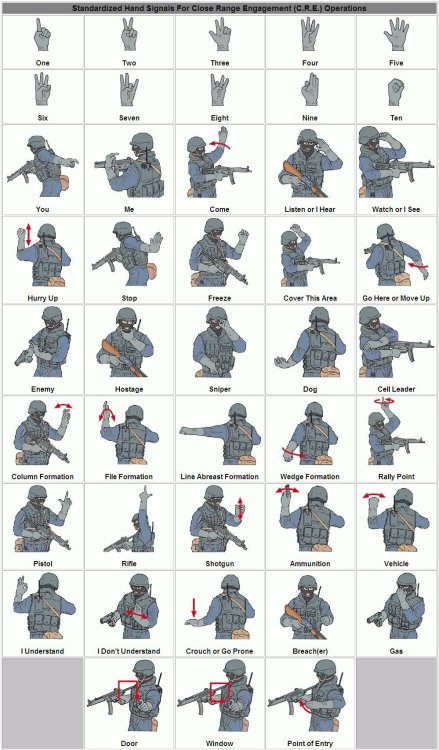
HUGE pet peeve of mine, I see it a lot in TV shows. The troops are walking quietly toward their objective. The leader holds up his hand in the halt signal and then
“THE ENEMIES ARE OVER THERE GUISE”
NO
The whole point of these hand signals is to be silent so the close range enemies you’re about to engage DON’T HEAR YOU GIVING COMMANDS
though why I’m still expecting sense out of tv shows I don’t even know
oH MY GOD
REBLOGGING THIS POST FOR SAFEKEEPING BECAUSE IT’S ABOUT 9000% RELEVANT TO CAPTAIN MOTHERFUCKING CROSS
iamtonysexual: bestnatesmithever: zerostatereflex: Tangible...
José M MCSi!!!! Como la de X Men!
El futuro está aqui!






MIT’s Tangible Media is coming along nicely,
"Almost like a table of living clay, the inFORM is a surface that three-dimensionally changes shape, allowing users to not only interact with digital content in meatspace, but even hold hands with a person hundreds of miles away. And that’s only the beginning."
handjobs of the future
HOLY SHIT ARE YOU KIDDING ME
THIS IS THE KIND OF CRAZY COOL-ASS SHIT THAT I’VE BEEN WAITING FOR MY WHOLE GODDAMN LIFE
LIKE
IN THOSE MOVIES AND GAMES AND SHIT WHERE PEOPLE HAVE THOSE CRAZY HIGH-TECH TABLES AND SUCH WHERE THEY MANIPULATE DATA AND VIRTUAL OBJECTS AND STUFF WITH THE WAVE OF A HAND AND SHIT
EVERY TIME I’M LIKE “…i want one”
AND WE’RE GETTING THERE
Un gel podría frenar la mayoría de las transmisiones del VIH por contacto sexual
José M MCQue clase de titular en una revista científica dice *podria frenar la "mayoria" * ? Que es esto, el Marca??
No es un espermicida, de modo que no puede prevenir los embarazos, pero este gel es un compuesto que se basa en el dendrímero 2G-S16, una molécula nanoscópica que bloquea la infección de las células epiteliales y del sistema inmune por el virus VIH. Una vez aplicado en la vagina o en el recto, tendría una eficacia de protección ante el virus transmisor del sida de hasta 24 horas.
Este nuevo gel ha sido presentado por la jefa de laboratorio de Inmunobiología Molecular del Gregorio Marañón, Ángeles Muñoz, y el profesor de Química Inorgánica de la Universidad de Alcalá, Javier de la Mata.
Vía | Sinc
-
La noticia Un gel podría frenar la mayoría de las transmisiones del VIH por contacto sexual fue publicada originalmente en Xatakaciencia por Sergio Parra.
Amazon Asks FAA For Permission To Test Its Delivery Drones
José M MCSiii, SiIiiiii! Skynet se acerca
 Amazon has petitioned the Federal Aviation Administration (FAA) for exemption from rules barring it from testing drones in the United States. The online shopping company made waves recently by showing off small unmanned aircraft that it claims will be able to deliver parcels to consumers in 30 minutes. The drone delivery service, called Prime Air, could greatly speed up Amazon’s… Read More
Amazon has petitioned the Federal Aviation Administration (FAA) for exemption from rules barring it from testing drones in the United States. The online shopping company made waves recently by showing off small unmanned aircraft that it claims will be able to deliver parcels to consumers in 30 minutes. The drone delivery service, called Prime Air, could greatly speed up Amazon’s… Read More
"i must go, my people need me"
José M MCOOOOooo!
Por favor, Dios, dime que es verdad y @DavidBisbal lo ha dicho de verdad
José M MCno puede ser verdad que haya escrito esto!!
Hugo Novel Review: Parasite by Mira Grant
José M MCMe intriga la premisa!!
written by David Steffen
 In the near future, The American medical corporation Symbogen releases a product that dramatically changes the medical industry–the Intestinal Bodyguard, a a genetically engineered tapeworm that manages most of your medical needs, including suppressing allergic reactions, and producing insulin for diabetics. Within a few years, the tapeworm implants are so ubiquitous, you would be hard pressed to find an American who doesn’t have one, and cheaper models have even become popular in third world countries where they help keep people healthy who have never known good health. They are the universal cure-all elixir. There can be no doubt that they have all the marvelous effects that are claimed–these are well documented. What may not be so well documented are the side effects that may come with that little traveling companion in your gut.
In the near future, The American medical corporation Symbogen releases a product that dramatically changes the medical industry–the Intestinal Bodyguard, a a genetically engineered tapeworm that manages most of your medical needs, including suppressing allergic reactions, and producing insulin for diabetics. Within a few years, the tapeworm implants are so ubiquitous, you would be hard pressed to find an American who doesn’t have one, and cheaper models have even become popular in third world countries where they help keep people healthy who have never known good health. They are the universal cure-all elixir. There can be no doubt that they have all the marvelous effects that are claimed–these are well documented. What may not be so well documented are the side effects that may come with that little traveling companion in your gut.
Sally Mitchell owes her life to the parasite, even more than most. She was involved in a terrible car accident, after which the doctors pronounced her permenantly braindead and urged her parents to remove her from life support. During that very discussion, she wakes up. She suffered from complete memory loss, to such an extent she had to relearn how to speak from scratch and had no memory of her previous life. Lacking memories of her old life, she became a completely different person but one who has learned to be completely functional within a few years, even holding down a job. She has to live with her parents and must make regular visits to Symbogen for them to study her condition further.
Symbogen’s interest in her has only increased with the recent increase in reports of the “sleeping sickness” which seems to be related to the parasites. Those afflicted with the sleeping sickness take on a state like sleepwalking without warning, even when they hadn’t been sleeping. And, sometimes, these sleepwalkers can be dangerous.
I’ve been looking forward to this novel, the first in the Parasitology trilogy, since I saw it on the Hugo list–the complete novel didn’t end up being in the Hugo packet, but I was able to get a review copy. I haven’t been familiar with Mira Grant’s (aka Seanan McGuire’s) for very long, but she’s gotten several award nominations these past few years that I’ve been following the award closely and her work has been good enough that I was very interested in reading a novel by her.
I thought that this was a solid novel, good through and through. I found Sal Mitchell a very relatable and interesting character, in a very interesting situation. She has learned enough language to be able to communicate fluently, but the youngness of her mind is clear in her spotty education on expressions and colloquialisms, and when she is lacking in some of the social norms that we generally take for granted. Her relationship with her boyfriend (Nathan Kim) is certainly not the point of the book, but was probably the part I enjoyed the most–a great example of a mutually supported relationship tuned to the individual people in it. All of the characters in the book were completely believable, even the ones with less savory aspects. I could believe everything in this book could really happen. Some of the characters gave me a strong enough impression that I had Hollywood actors picked out for their movie portrayals–for those reading along, I pictured Andy Serkis as Sherman and Ben Kingsley as Colonel Mitchell (Sally’s father).
Although this book has been billed as horror, I didn’t find it terribly horrific. Of course with tapeworm implants being a major factor there is potential that some might get grossed out by those parts, but I didn’t think anything was going for a squick factor in that. I think it would do just as well with a general SF audience, unless you’re particularly sensitive to the idea of the tapeworms, in which case you probably haven’t read this far anyway.
My first complaint is that there was a twist reveal late in the book that perplexed me a bit because I thought the knowledge given in the reveal had been a foregone conclusion since page 1 of the book. Understandably, that is from my perspective as a lifetime SF fan looking in from the outside of the situation, so it’s understandable if people in the actual story wouldn’t see it right away, but I thought there was enough evidence even within the story itself that some of them should’ve figured this reveal out long before it was handed to them–that was the one area where the characters didn’t behave as I thought they would.
My second complaint, admittedly a minor one, is that this doesn’t stand alone as a single book. My favorite series are those where each book is its own complete arc while also being part of the larger arc of the series. That’s not the case here–rather than resolving anything at the end, several more cans of worms are opened and then the book is over. Of course, wanting a full arc per book is a personal preference and certainly not a requirement of a writer.
I would highly recommend this book, and I eagerly await reading the second and third books in the series.
Así es la tecnología y el diseño del nuevo Citroën C4 Cactus
José M MCLa pantalla con direccion de ruta es muy Coche fantastico!!!

En ALT1040 hemos tenido la oportunidad de probar el nuevo Citroën C4 Cactus, con un diseño muy rompedor que apela a las emociones mediante una estética no vista hasta ahora y un punto tecnológico muy interesante para controlar todos los aspectos del coche.
Este fin de semana Citroën ha aprovechado para presentar a la prensa el nuevo Citroën C4 Cactus en Ámsterdam y hemos tenido la oportunidad de probarlo. El nuevo C4 Cactus es un coche diferente, un modelo que se sale de lo que estamos acostumbrados a ver por las calles y que genera sentimientos enfrentados, pero positivos al fin y al cabo.
Lógicamente, lo primero que llama la atención de este coches es su arriesgada estética exterior y algunos elementos de la misma que hasta ahora no habíamos visto en ningún otro modelo de la marca, como las almohadillas laterales -que Citroën ha bautizado con el nombre de Airbumps-, algo que puede desplazar la balanza en los dos sentidos a la hora de decidir la compra. Diferente es la palabra con la que se podría catalogar al C4 Cactus y que desde luego es su principal carta de presentación.
Amplia variedad de colores y combinaciones, tanto de los acabados interiores y exteriores, junto con una precio muy ajustado, una gama de motores para todos los gustos, peso y consumo reducidos y varios detalles tecnológicos muy interesantes son sus principales características. Pero, ¿cómo es a la hora de la verdad el nuevo C4 Cactus en términos de diseño y tecnología?
Diseño, acabados y Airbumps
Diseño, es la principal características del Citroën C4 Cactus. Desde su amplia variedad de colores y combinaciones hasta el diseño general del vehículo es lo que más llama la atención. De hecho, en la rueda de prensa preliminar de Citroën y a hicieron bastante hincapié en el diseño como motor de emociones. El nuevo Citröen C4 Cactus está disponible en una amplia gama de colores, tanto de la pintura exterior como de combinaciones de los elementos de protección y acabados interiores, que pese a que estos últimos no son de alta gama, cumplen de forma bastante correcta dentro de gama y sector de mercado donde se engloba el C4 Cactus.

Airbumps es la tecnología de Citroën para proteger el exterior del C4 Cactus disponible en varios colores
Uno de los elementos más reseñabes son sin duda las protecciones laterales, delanteras y traseras del Cactus a las que Citroën ha llamado Airbumps, que no son más que protecciones de poliuretano de distintos colores y acolchadas con una base de aire que añaden una protección extra frente a golpes y arañazos comunes y suponen un cambio interesante en términos de diseño; y aunque a primera vista parece que no acaban de encajar, tras darle un par de vueltas añaden bastante personalidad por ser algo único en el mercado, convirtiéndose en un elemento más del coche bastante interesante para su protección.
Lógicamente, esta protección no va a hacer nada contra un golpe fuerte, pero si que va proteger la carrocería frente a pequeños golpes y arañazos. Lo más interesante de todo es que se trata de elementos de protección que pueden cambiarse fácilmente por 100 euros cada uno, mucho más barato que reparar los arañazos o repintar el vehículo, por lo que se convierten en una característica muy interesante que de momento solo está disponible en este modelo y que podremos combinar con el resto de carrocería en colores beige/duna, chocolate y gris.

Acabados muy interesantes con diferentes combinaciones de color
El resto de acabados de este Citroën son bastante competentes. Desde los asientos, disponibles en tela o con combinaciones de piel, hasta el diseño de los interiores, donde abunda el plástico pero de buena construcción, hacen del C4 Cactus un vehículo muy correcto y competente si los comparamos con otro modelos similares -al menos los del mismo segmento-. El interior es muy amplio, de hecho sorprende cuando te subes por primera vez; pero una de las características que más me ha llamado la atención es el techo panorámico que aporta muchísima iluminación al coche y aumenta su sensación de amplitud.
Tanto el cuadro de mandos, como el volante mutifunción -disponible de serie en todos los modelos de la gama- completan un interior enfocado a la tecnología al servicio del conductor, con espejos eléctricos, sistema multifunción para el control multimedia y control de crucero con limitador de velocidad, que funciona francamente bien y de forma bastante intuitiva, para que no tengamos que quitar los ojos de la carretera.
Tecnología: Multicity Connect

Uno de los puntos que pusimos bajo la lupa de ALT1040 fue el apartado tecnológico del nuevo C4 Cactus. Tal como ya habían confirmado, el sistema de este modelo parte del Multicity Connect de Citroën que ya vimos en el Grand C4 Picasso y C4 Picasso, por lo que esperábamos pocos cambios en ese sentido.
En general, el sistema tecnológico del C4 Cactus está gobernado por una enorme pantalla central de 7" pulgadas donde se localizan la mayoría de funciones del Multicity, acompañando a esta se encuentran otra pantalla tipo LED con el velocímetro, el indicador de velocidad y el aviso de cambio de velocidad, en la que Citroën se ha olvidado de incluir el cuenta revoluciones, que pese a llevar aviso de cambio, se hecha en falta. Le acompañan una entrada de audio auxiliar, uno o dos USB para conectar el movil en función del modelo y la cámara trasera y sensor de aparcamiento, también opcional.
Multicity Connect es muy interesante, pero se echa en falta mayor agilidad del sistema
La pantalla central de 7 pulgadas es el auténtico centro de mando del equipamiento tecnológico del vehículo, a la que se suma el Multicity Connect, un dispositivo USB para dotar de conectividad al coche y que aporta conexión a internet a las aplicaciones de sistema a través de un suscripción 3G. En el modelo que nosotros pudimos probar se trata de un modem USB de Qualcomm.
El sistema de entrenamiento del C4 Cactus ofrece una serie de aplicaciones muy interesantes enfocadas a la conducción: Coyote para avisos de radares e imprevistos en la calzada, Copilot como sistema de Mapas GPS -bastante completo-, guía Michelín, Trip Advisor, Facebook, Tiempo, MyCitroën... aplicaciones al fin y al cabo enfocadas a su uso dentro del vehículo, a la conducción y a la planificación de viajes. En este sentido, nada que objetar.
Pero el sistema de Citroën tiene un pequeño problema: es lento, muy lento, tanto para interactuar con la pantalla -del tipo resistiva- como para cambiar entre aplicaciones; lentitud que parece que se soluciona momentáneamente al desconectar el sistema Multicity Connect, por lo que suponemos que se trata de software sin depurar, que Citroën podrá mejorar en futuras actualizaciones del software. El resto, lo complementan algunos botones capacitivos con accesos directos a las funciones más interesantes del sistema en el marco de la pantalla.

A pesar de contar con conectividad 3G y un amplio catálogo de aplicaciones, uno de los puntos fuertes que más destacan del sistema de Citroën es sin duda su apartado multimedia. Con dos USBs disponibles para conectar nuestro terminal y 16GB de memoria disponible, Citroën ha convertido a los vehículos que usan su sistema en verdaderos centros multimedias, toda la música, el teléfono o los contactos están disponibles como por arte de mágia para reproducir desde el coche, sin necesidad de interacción por parte del usuario, lo que lo convierte en un gran punto a tener en cuenta, y más en el segmento de mercado al que va enfocado.
¿Hay margen de mejora en el apartado tecnológico del nuevo Cactus? Sí, pero dentro de su precio incluye opciones muy interesantes que lo convierten en un coche muy completo incluso sin echar de menos los extras que ofrece la casa. Extras que por otro lado complementan un apartado tecnológico, ya de por si bastante notable, como el park assist o la cámara y sensores de aparcamiento traseros, opcionales.
El nuevo Citroën C4 Cactus tiene un precio variable en función las distintos motores, acabado y extras que parte desde los 14 750,00 €, y ya está disponible en España en los concesionarios oficiales Citroën. Y vistas sus características y su diseño, no será extraño verlo bastante a menudo por nuestras calles.
Immerse yourself in stillness with Rock Simulator 2014

Yep, you read that right. You can pretend to be a rock in Rock Simulator 2014, a forthcoming title which gamers have voted the ninth most exciting on Steam's 'Greenlight' platform.
Following in the footsteps of titles like Truck Simulator, Surgeon Simulator, Bear Simulator and even Goat Simulator, Rock Simulator is an immersive, highly-detailed look at what it's like to be a rock.
By: Duncan Geere,
Continue reading...155. BANKSY: Taking the piss (explicit)
José M MCmola! (abrirlo pa ver el comic)
RELATED COMICS: Sophie Scholl The Fire Within. Marc Maron The Social Media Generation. Bill Hicks It’s Just a Ride. Henry Rollins Who’s the Crazier Man?
Banksy is an anoynomous English street artist and activist who has become a cult hero for his anti-establishment and rebellious artwork.
Unlike someone I know, who stays in his house all day drawing comics and watching Simpsons reruns, Banksy is a REAL artist who challenges the status quo, forces people to think and puts himself in danger, all while remaining a complete mystery to the world. I mean think about it, he’s one of the most famous artists on the planet, his work has been popping up in major cities for the past 10 years and sell for millions of dollars and no one knows who the hell this guy is! I take my hat off to the dude.
If you haven’t seen it, I recommend the documentary Banksy directed, Exit Through the Gift Shop. What was meant to be a film about Banksy instead turned into a movie about the man who was obsessed in trying to meet him. Although many have claimed that it’s a ‘mockumentary’ and the plot a set-up, it’s still a brilliant film. It not only documents the street art movement, it also deals with the meaning of art, and whether or not an artist actually needs any talent or can just survive on hype alone. Two thumbs up!
This quote was taken from Banksy’s 2004 book Cut It Out. Some of the passage was inspired/appropriated from an essay by artist Sean Tejaratchi. I rearranged the last couple of sentences for this comic.
- Banksy’s official website.
- Speaking of The Simpsons, check out Banksy’s opening couch gag.
- I posted a video about my upcoming trip to America. I’ll be having meet-ups in Portland, San Francisco and a signing at San Diego Comic Con.
The Fermi Paradox
Everyone feels something when they’re in a really good starry place on a really good starry night and they look up and see this:
Some people stick with the traditional, feeling struck by the epic beauty or blown away by the insane scale of the universe. Personally, I go for the old “existential meltdown followed by acting weird for the next half hour.” But everyone feels something.
Physicist Enrico Fermi felt something too—”Where is everybody?”
________________
A really starry sky seems vast—but all we’re looking at is our very local neighborhood. On the very best nights, we can see up to about 2,500 stars (roughly one hundred-millionth of the stars in our galaxy), and almost all of them are less than 1,000 light years away from us (or 1% of the diameter of the Milky Way). So what we’re really looking at is this:
When confronted with the topic of stars and galaxies, a question that tantalizes most humans is, “Is there other intelligent life out there?” Let’s put some numbers to it (if you don’t like numbers, just read the bold)—
As many stars as there are in our galaxy (100 – 400 billion), there are roughly an equal number of galaxies in the observable universe—so for every star in the colossal Milky Way, there’s a whole galaxy out there. All together, that comes out to the typically quoted range of between 1022 and 1024 total stars, which means that for every grain of sand on Earth, there are 10,000 stars out there.
The science world isn’t in total agreement about what percentage of those stars are “sun-like” (similar in size, temperature, and luminosity)—opinions typically range from 5% to 20%. Going with the most conservative side of that (5%), and the lower end for the number of total stars (1022), gives us 500 quintillion, or 500 billion billion sun-like stars.
There’s also a debate over what percentage of those sun-like stars might be orbited by an Earth-like planet (one with similar temperature conditions that could have liquid water and potentially support life similar to that on Earth). Some say it’s as high as 50%, but let’s go with the more conservative 22% that came out of a recent PNAS study. That suggests that there’s a potentially-habitable Earth-like planet orbiting at least 1% of the total stars in the universe—a total of 100 billion billion Earth-like planets.
So there are 100 Earth-like planets for every grain of sand in the world. Think about that next time you’re on the beach.
Moving forward, we have no choice but to get completely speculative. Let’s imagine that after billions of years in existence, 1% of Earth-like planets develop life (if that’s true, every grain of sand would represent one planet with life on it). And imagine that on 1% of those planets, the life advances to an intelligent level like it did here on Earth. That would mean there were 10 quadrillion, or 10 million billion intelligent civilizations in the observable universe.
Moving back to just our galaxy, and doing the same math on the lowest estimate for stars in the Milky Way (100 billion), we’d estimate that there are 1 billion Earth-like planets and 100,000 intelligent civilizations in our galaxy.[1]The Drake Equation provides a formal method for this narrowing-down process we’re doing.
SETI (Search for Extraterrestrial Intelligence) is an organization dedicated to listening for signals from other intelligent life. If we’re right that there are 100,000 or more intelligent civilizations in our galaxy, and even a fraction of them are sending out radio waves or laser beams or other modes of attempting to contact others, shouldn’t SETI’s satellite array pick up all kinds of signals?
But it hasn’t. Not one. Ever.
Where is everybody?
It gets stranger. Our sun is relatively young in the lifespan of the universe. There are far older stars with far older Earth-like planets, which should in theory mean civilizations far more advanced than our own. As an example, let’s compare our 4.54 billion-year-old Earth to a hypothetical 8 billion-year-old Planet X.
If Planet X has a similar story to Earth, let’s look at where their civilization would be today (using the orange timespan as a reference to show how huge the green timespan is):
The technology and knowledge of a civilization only 1,000 years ahead of us could be as shocking to us as our world would be to a medieval person. A civilization 1 million years ahead of us might be as incomprehensible to us as human culture is to chimpanzees. And Planet X is 3.4 billion years ahead of us…
There’s something called The Kardashev Scale, which helps us group intelligent civilizations into three broad categories by the amount of energy they use:
A Type I Civilization has the ability to use all of the energy on their planet. We’re not quite a Type I Civilization, but we’re close (Carl Sagan created a formula for this scale which puts us at a Type 0.7 Civilization).
A Type II Civilization can harness all of the energy of their host star. Our feeble Type I brains can hardly imagine how someone would do this, but we’ve tried our best, imagining things like a Dyson Sphere.
A Type III Civilization blows the other two away, accessing power comparable to that of the entire Milky Way galaxy.
If this level of advancement sounds hard to believe, remember Planet X above and their 3.4 billion years of further development. If a civilization on Planet X were similar to ours and were able to survive all the way to Type III level, the natural thought is that they’d probably have mastered inter-stellar travel by now, possibly even colonizing the entire galaxy.
One hypothesis as to how galactic colonization could happen is by creating machinery that can travel to other planets, spend 500 years or so self-replicating using the raw materials on their new planet, and then send two replicas off to do the same thing. Even without traveling anywhere near the speed of light, this process would colonize the whole galaxy in 3.75 million years, a relative blink of an eye when talking in the scale of billions of years:
Source: Scientific American: “Where Are They”
Continuing to speculate, if 1% of intelligent life survives long enough to become a potentially galaxy-colonizing Type III Civilization, our calculations above suggest that there should be at least 1,000 Type III Civilizations in our galaxy alone—and given the power of such a civilization, their presence would likely be pretty noticeable. And yet, we see nothing, hear nothing, and we’re visited by no one.
So where is everybody?
_____________________
Welcome to the Fermi Paradox.
We have no answer to the Fermi Paradox—the best we can do is “possible explanations.” And if you ask ten different scientists what their hunch is about the correct one, you’ll get ten different answers. You know when you hear about humans of the past debating whether the Earth was round or if the sun revolved around the Earth or thinking that lightning happened because of Zeus, and they seem so primitive and in the dark? That’s about where we are with this topic.
In taking a look at some of the most-discussed possible explanations for the Fermi Paradox, let’s divide them into two broad categories—those explanations which assume that there’s no sign of Type II and Type III Civilizations because there are none of them out there, and those which assume they’re out there and we’re not seeing or hearing anything for other reasons:
Explanation Group 1: There are no signs of higher (Type II and III) civilizations because there are no higher civilizations in existence.
Those who subscribe to Group 1 explanations point to something called the non-exclusivity problem, which rebuffs any theory that says, “There are higher civilizations, but none of them have made any kind of contact with us because they all _____.” Group 1 people look at the math, which says there should be so many thousands (or millions) of higher civilizations, that at least one of them would be an exception to the rule. Even if a theory held for 99.99% of higher civilizations, the other .01% would behave differently and we’d become aware of their existence.
Therefore, say Group 1 explanations, it must be that there are no super-advanced civilizations. And since the math suggests that there are thousands of them just in our own galaxy, something else must be going on.
This something else is called The Great Filter.
The Great Filter theory says that at some point from pre-life to Type III intelligence, there’s a wall that all or nearly all attempts at life hit. There’s some stage in that long evolutionary process that is extremely unlikely or impossible for life to get beyond. That stage is The Great Filter.
If this theory is true, the big question is, Where in the timeline does the Great Filter occur?
It turns out that when it comes to the fate of humankind, this question is very important. Depending on where The Great Filter occurs, we’re left with three possible realities: We’re rare, we’re first, or we’re fucked.
1. We’re Rare (The Great Filter is Behind Us)
One hope we have is that The Great Filter is behind us—we managed to surpass it, which would mean it’s extremely rare for life to make it to our level of intelligence. The diagram below shows only two species making it past, and we’re one of them.
This scenario would explain why there are no Type III Civilizations…but it would also mean that we could be one of the few exceptions now that we’ve made it this far. It would mean we have hope. On the surface, this sounds a bit like people 500 years ago suggesting that the Earth is the center of the universe—it implies that we’re special. However, something scientists call “observation selection effect” suggests that anyone who is pondering their own rarity is inherently part of an intelligent life “success story”—and whether they’re actually rare or quite common, the thoughts they ponder and conclusions they draw will be identical. This forces us to admit that being special is at least a possibility.
And if we are special, when exactly did we become special—i.e. which step did we surpass that almost everyone else gets stuck on?
One possibility: The Great Filter could be at the very beginning—it might be incredibly unusual for life to begin at all. This is a candidate because it took about a billion years of Earth’s existence to finally happen, and because we have tried extensively to replicate that event in labs and have never been able to do it. If this is indeed The Great Filter, it would mean that not only is there no intelligent life out there, there may be no other life at all.
Another possibility: The Great Filter could be the jump from the simple prokaryote cell to the complex eukaryote cell. After prokaryotes came into being, they remained that way for almost two billion years before making the evolutionary jump to being complex and having a nucleus. If this is The Great Filter, it would mean the universe is teeming with simple prokaryote cells and almost nothing beyond that.
There are a number of other possibilities—some even think the most recent leap we’ve made to our current intelligence is a Great Filter candidate. While the leap from semi-intelligent life (chimps) to intelligent life (humans) doesn’t at first seem like a miraculous step, Steven Pinker rejects the idea of an inevitable “climb upward” of evolution: “Since evolution does not strive for a goal but just happens, it uses the adaptation most useful for a given ecological niche, and the fact that, on Earth, this led to technological intelligence only once so far may suggest that this outcome of natural selection is rare and hence by no means a certain development of the evolution of a tree of life.”
Most leaps do not qualify as Great Filter candidates. Any possible Great Filter must be one-in-a-billion type thing where one or more total freak occurrences need to happen to provide a crazy exception—for that reason, something like the jump from single-cell to multi-cellular life is ruled out, because it has occurred as many as 46 times, in isolated incidents, just on this planet alone. For the same reason, if we were to find a fossilized eukaryote cell on Mars, it would rule the above “simple-to-complex cell” leap out as a possible Great Filter (as well as anything before that point on the evolutionary chain)—because if it happened on both Earth and Mars, it’s almost definitely not a one-in-a-billion freak occurrence.
If we are indeed rare, it could be because of a fluky biological event, but it also could be attributed to what is called the Rare Earth Hypothesis, which suggests that though there may be many Earth-like planets, the particular conditions on Earth—whether related to the specifics of this solar system, its relationship with the moon (a moon that large is unusual for such a small planet and contributes to our particular weather and ocean conditions), or something about the planet itself—are exceptionally friendly to life.
2. We’re the First
For Group 1 Thinkers, if the Great Filter is not behind us, the one hope we have is that conditions in the universe are just recently, for the first time since the Big Bang, reaching a place that would allow intelligent life to develop. In that case, we and many other species may be on our way to super-intelligence, and it simply hasn’t happened yet. We happen to be here at the right time to become one of the first super-intelligent civilizations.
One example of a phenomenon that could make this realistic is the prevalence of gamma-ray bursts, insanely huge explosions that we’ve observed in distant galaxies. In the same way that it took the early Earth a few hundred million years before the asteroids and volcanoes died down and life became possible, it could be that the first chunk of the universe’s existence was full of cataclysmic events like gamma-ray bursts that would incinerate everything nearby from time to time and prevent any life from developing past a certain stage. Now, perhaps, we’re in the midst of an astrobiological phase transition and this is the first time any life has been able to evolve for this long, uninterrupted.
3. We’re Fucked (The Great Filter is Ahead of Us)
If we’re neither rare nor early, Group 1 thinkers conclude that The Great Filter must be in our future. This would suggest that life regularly evolves to where we are, but that something prevents life from going much further and reaching high intelligence in almost all cases—and we’re unlikely to be an exception.
One possible future Great Filter is a regularly-occurring cataclysmic natural event, like the above-mentioned gamma-ray bursts, except they’re unfortunately not done yet and it’s just a matter of time before all life on Earth is suddenly wiped out by one. Another candidate is the possible inevitability that nearly all intelligent civilizations end up destroying themselves once a certain level of technology is reached.
This is why Oxford University philosopher Nick Bostrom says that “no news is good news.” The discovery of even simple life on Mars would be devastating, because it would cut out a number of potential Great Filters behind us. And if we were to find fossilized complex life on Mars, Bostrom says “it would be by far the worst news ever printed on a newspaper cover,” because it would mean The Great Filter is almost definitely ahead of us—ultimately dooming the species. Bostrom believes that when it comes to The Fermi Paradox, “the silence of the night sky is golden.”
Explanation Group 2: Type II and III intelligent civilizations are out there—and there are logical reasons why we might not have heard from them.
Group 2 explanations get rid of any notion that we’re rare or special or the first at anything—on the contrary, they believe in the Mediocrity Principle, whose starting point is that there is nothing unusual or rare about our galaxy, solar system, planet, or level of intelligence, until evidence proves otherwise. They’re also much less quick to assume that the lack of evidence of higher intelligence beings is evidence of their nonexistence—emphasizing the fact that our search for signals stretches only about 100 light years away from us (0.1% across the galaxy) and suggesting a number of possible explanations. Here are 10:
Possibility 1) Super-intelligent life could very well have already visited Earth, but before we were here. In the scheme of things, sentient humans have only been around for about 50,000 years, a little blip of time. If contact happened before then, it might have made some ducks flip out and run into the water and that’s it. Further, recorded history only goes back 5,500 years—a group of ancient hunter-gatherer tribes may have experienced some crazy alien shit, but they had no good way to tell anyone in the future about it.
Possibility 2) The galaxy has been colonized, but we just live in some desolate rural area of the galaxy. The Americas may have been colonized by Europeans long before anyone in a small Inuit tribe in far northern Canada realized it had happened. There could be an urbanization component to the interstellar dwellings of higher species, in which all the neighboring solar systems in a certain area are colonized and in communication, and it would be impractical and purposeless for anyone to deal with coming all the way out to the random part of the spiral where we live.
Possibility 3) The entire concept of physical colonization is a hilariously backward concept to a more advanced species. Remember the picture of the Type II Civilization above with the sphere around their star? With all that energy, they might have created a perfect environment for themselves that satisfies their every need. They might have crazy-advanced ways of reducing their need for resources and zero interest in leaving their happy utopia to explore the cold, empty, undeveloped universe.
An even more advanced civilization might view the entire physical world as a horribly primitive place, having long ago conquered their own biology and uploaded their brains to a virtual reality, eternal-life paradise. Living in the physical world of biology, mortality, wants, and needs might seem to them the way we view primitive ocean species living in the frigid, dark sea. FYI, thinking about another life form having bested mortality makes me incredibly jealous and upset.
Possibility 4) There are scary predator civilizations out there, and most intelligent life knows better than to broadcast any outgoing signals and advertise their location. This is an unpleasant concept and would help explain the lack of any signals being received by the SETI satellites. It also means that we might be the super naive newbies who are being unbelievably stupid and risky by ever broadcasting outward signals. There’s a debate going on currently about whether we should engage in METI (Messaging to Extraterrestrial Intelligence—the reverse of SETI) or not, and most people say we should not. Stephen Hawking warns, “If aliens visit us, the outcome would be much as when Columbus landed in America, which didn’t turn out well for the Native Americans.” Even Carl Sagan (a general believer that any civilization advanced enough for interstellar travel would be altruistic, not hostile) called the practice of METI “deeply unwise and immature,” and recommended that “the newest children in a strange and uncertain cosmos should listen quietly for a long time, patiently learning about the universe and comparing notes, before shouting into an unknown jungle that we do not understand.” Scary.[2]Thinking about this logically, I think we should disregard all the warnings get the outgoing signals rolling. If we catch the attention of super-advanced beings, yes, they might decide to wipe out our whole existence, but that’s not that different than our current fate (to each die within a century). And maybe, instead, they’d invite us to upload our brains into their eternal virtual utopia, which would solve the death problem and also probably allow me to achieve my childhood dream of bouncing around on the clouds. Sounds like a good gamble to me.
Possibility 5) There’s only one instance of higher-intelligent life—a “superpredator” civilization (like humans are here on Earth)—who is far more advanced than everyone else and keeps it that way by exterminating any intelligent civilization once they get past a certain level. This would suck. The way it might work is that it’s an inefficient use of resources to exterminate all emerging intelligences, maybe because most die out on their own. But past a certain point, the super beings make their move—because to them, an emerging intelligent species becomes like a virus as it starts to grow and spread. This theory suggests that whoever was the first in the galaxy to reach intelligence won, and now no one else has a chance. This would explain the lack of activity out there because it would keep the number of super-intelligent civilizations to just one.
Possibility 6) There’s plenty of activity and noise out there, but our technology is too primitive and we’re listening for the wrong things. Like walking into a modern-day office building, turning on a walkie-talkie, and when you hear no activity (which of course you wouldn’t hear because everyone’s texting, not using walkie-talkies), determining that the building must be empty. Or maybe, as Carl Sagan has pointed out, it could be that our minds work exponentially faster or slower than another form of intelligence out there—e.g. it takes them 12 years to say “Hello,” and when we hear that communication, it just sounds like white noise to us.
Possibility 7) We are receiving contact from other intelligent life, but the government is hiding it. This is an idiotic theory, but I had to mention it because it’s talked about so much.
Possibility 8) Higher civilizations are aware of us and observing us (AKA the “Zoo Hypothesis”). As far as we know, super-intelligent civilizations exist in a tightly-regulated galaxy, and our Earth is treated like part of a vast and protected national park, with a strict “Look but don’t touch” rule for planets like ours. We wouldn’t notice them, because if a far smarter species wanted to observe us, it would know how to easily do so without us realizing it. Maybe there’s a rule similar to the Star Trek’s “Prime Directive” which prohibits super-intelligent beings from making any open contact with lesser species like us or revealing themselves in any way, until the lesser species has reached a certain level of intelligence.
Possibility 9) Higher civilizations are here, all around us. But we’re too primitive to perceive them. Michio Kaku sums it up like this:
Lets say we have an ant hill in the middle of the forest. And right next to the ant hill, they’re building a ten-lane super-highway. And the question is “Would the ants be able to understand what a ten-lane super-highway is? Would the ants be able to understand the technology and the intentions of the beings building the highway next to them?
So it’s not that we can’t pick up the signals from Planet X using our technology, it’s that we can’t even comprehend what the beings from Planet X are or what they’re trying to do. It’s so beyond us that even if they really wanted to enlighten us, it would be like trying to teach ants about the internet.
Along those lines, this may also be an answer to “Well if there are so many fancy Type III Civilizations, why haven’t they contacted us yet?” To answer that, let’s ask ourselves—when Pizarro made his way into Peru, did he stop for a while at an anthill to try to communicate? Was he magnanimous, trying to help the ants in the anthill? Did he become hostile and slow his original mission down in order to smash the anthill apart? Or was the anthill of complete and utter and eternal irrelevance to Pizarro? That might be our situation here.
Possibility 10) We’re completely wrong about our reality. There are a lot of ways we could just be totally off with everything we think. The universe might appear one way and be something else entirely, like a hologram. Or maybe we’re the aliens and we were planted here as an experiment or as a form of fertilizer. There’s even a chance that we’re all part of a computer simulation by some researcher from another world, and other forms of life simply weren’t programmed into the simulation.
________________
As we continue along with our possibly-futile search for extraterrestrial intelligence, I’m not really sure what I’m rooting for. Frankly, learning either that we’re officially alone in the universe or that we’re officially joined by others would be creepy, which is a theme with all of the surreal storylines listed above—whatever the truth actually is, it’s mindblowing.
Beyond its shocking science fiction component, The Fermi Paradox also leaves me with a deep humbling. Not just the normal “Oh yeah, I’m microscopic and my existence lasts for three seconds” humbling that the universe always triggers. The Fermi Paradox brings out a sharper, more personal humbling, one that can only happen after spending hours of research hearing your species’ most renowned scientists present insane theories, change their minds again and again, and wildly contradict each other—reminding us that future generations will look at us the same way we see the ancient people who were sure that the stars were the underside of the dome of heaven, and they’ll think “Wow they really had no idea what was going on.”
Compounding all of this is the blow to our species’ self-esteem that comes with all of this talk about Type II and III Civilizations. Here on Earth, we’re the king of our little castle, proud ruler of the huge group of imbeciles who share the planet with us. And in this bubble with no competition and no one to judge us, it’s rare that we’re ever confronted with the concept of being a dramatically inferior species to anyone. But after spending a lot of time with Type II and III Civilizations over the past week, our power and pride are seeming a bit David Brent-esque.
That said, given that my normal outlook is that humanity is a lonely orphan on a tiny rock in the middle of a desolate universe, the humbling fact that we’re probably not as smart as we think we are, and the possibility that a lot of what we’re sure about might be wrong, sounds wonderful. It opens the door just a crack that maybe, just maybe, there might be more to the story than we realize.
To humble you further:
More from Wait But Why:
Why Generation Y Yuppies Are Unhappy
7 Ways to be Insufferable on Facebook
Why Procrastinators Procrastinate
How to Name a Baby
How to Pick Your Life Partner
Your Life in Weeks
10 Types of 30-Year-Old Single Guys
The Great Perils of Social Interaction
Sources:
PNAS: Prevalence of Earth-size planets orbiting Sun-like stars
SETI: The Drake Equation
NASA: Workshop Report on the Future of Intelligence In The Cosmos
Cornell University Library: The Fermi Paradox, Self-Replicating Probes, and the Interstellar Transportation Bandwidth
NCBI: Astrobiological phase transition: towards resolution of Fermi’s paradox
André Kukla: Extraterrestrials: A Philosophical Perspective
Nick Bostrom: Where Are They?
Science Direct: Galactic gradients, postbiological evolution and the apparent failure of SETI
Nature: Simulations back up theory that Universe is a hologram
Robin Hanson: The Great Filter – Are We Almost Past It?
John Dyson: Search for Artificial Stellar Sources of Infrared Radiation
Singslator traduce del español a la lengua de signos directamente desde la web

¿Cuántos de los aquí presentes sabéis hablar con la lengua de signos? La probable respuesta es que ninguno, o muy pocos. Esta lengua es básica para comunicarnos con personas sordas, y es algo que se ha aprovechado muy poco en internet con herramientas demasiado específicas. Singslator es una web que viene a cambiar eso.
El portal no puede ser más sencillo: entras, escribes lo que quieres traducir y una mujer nos lo traducirá a la lengua de signos. Incluso podremos leer en tiempo real las palabras cambiadas que está utilizando, para que nosotros mismos también podamos aprender. Hay más de 12.000 palabras que se pueden traducir.
La página está hecha en Flash, aunque no lo voy a tachar de inconveniente ya que hacer algo así con el estándar HTML5 es muy complicado. De hecho Singslator ha implicado 200 horas de grabación de pequeños vídeos y 750 horas de programación, así que creo que no se les puede decir que no se han esforzado. Una herramienta, desde luego, esencial para algunos.
En Genbeta | Las redes sociales tienen la obligación legal de ser accesibles
-
La noticia Singslator traduce del español a la lengua de signos directamente desde la web fue publicada originalmente en Genbeta por Miguel López.
#PayForYourPorn, las actrices porno contra el gratis en Internet
José M MCPoobres! :(

En Genbeta ya hemos visto cómo la pornografía, por muy tema tabú que sea, juega un papel importante en la red. Hay toda una industria detrás de los vídeos para adultos que también está experimentando los efectos de la red, de la misma forma con la que otros mercados sufren sus efectos.
Y como es de esperar, el mayor problema de la industria pornográfica es ahora mismo la proliferación de portales de vídeos gratuitos como PornHub y la piratería de las películas profesionales para adultos. Un dato que ya dimos lo demuestra: más de un tercio de los torrents que se suben a The Pirate Bay son porno.
Ya existen versiones adultas de Netflix como Skweezme, donde podemos pagar 3 dólares por 24 horas de vídeos de alta calidad
¿Cuál está siendo la respuesta por parte de algunos profesionales del sector? El movimiento #PayForYourPorn, que promueve que los usuarios paguen cuando quieran ver vídeos para adultos; y algunos sitios web como Skweezme que vienen a ser un "Netflix porno" desde donde podemos acceder a vídeos adultos de calidad durante 24 horas por menos de 3 dólares. Otros portales como Wicked Pictures también lo hacen por 29,99 dólares cada mes.
Los responsables de ambos portales coinciden cuando hablaron en un artículo de VICE sobre el tema: "la gente sólo quiere poner algún vídeo corto y rápido, hacerse una paja rápida y terminar en cinco minutos", dice el fundador de Skweezme Mike Kulich. #PayForYourPorn quiere animar a todos los consumidores de pornografía a que lo hagan en algún servicio de pago, para que así la industria pueda tener fondos para seguir funcionando. Si no, ésta se ve forzada a recortar presupuesto y a rebajar la calidad de sus producciones.
El porno gratis manda, lo mires como lo mires

No nos olvidemos tampoco de lo que se podría considerar como "la democratización" del porno: la tecnología actual permite que cualquier pareja que no sea tímida pueda grabarse durante un coito (y no hace falta que sean dos, una persona sola también) y subir el vídeo a cualquier portal de vídeos. Son varios factores que, en definitiva, complican el negocio del porno tal y como lo hemos conocido.
Miremos algunas cifras para entender mejor la situación. Según un informe de Covenant Eyes (un software que filtra contenido), el 70% del material pornográfico que hay ahora mismo en la red se encuentra en portales de vídeo gratuitos. Aunque todo sea dicho, la mayoría de ese contenido promociona el acceso de pago a esos mismos o a otros portales. De todo ese contenido, los portales adquieren un 90% mientras que el 10% lo crean ellos mismos. Y hay muchas visitas: el tráfico del portal XVideo supera los 29 PetaBytes (más de 29.000 TeraBytes) mensuales.
1 de cada 4 británicos tiene porno almacenado en su móvil
La revolución móvil también se sube al carro: una de cada cinco búsquedas en Google desde smartphones van a por contenido adulto, y uno de cada cuatro británicos han admitido en una encuesta que tienen porno guardado en su móvil. Y el 84% de las parejas de esos encuestados no lo saben.
¿Cómo pinta el futuro? Para el 2015, se espera que la industria del porno en la red sea ya un negocio de 2.800 millones de dólares con más de mil millones pagados en suscripciones de portales de pago. Los móviles que reproducirán ese contenido se habrán triplicado, y la aproximación que se calcula es de 35 millones personas suscritas a algún servicio alrededor de todo el mundo.
Será toda una batalla para que el negocio de la pornografía, como está ocurriendo con la música y las películas/series, se adapte a los nuevos tiempos.
Hablan las actrices
 La actriz porno Dunia Montenegro. Fuente: Twitter
La actriz porno Dunia Montenegro. Fuente: Twitter Y con todo este panorama, hemos querido preguntar a profesionales del sector para que nos den su opinión sobre el tema: ¿Han notado este cambio? ¿Cómo ven el futuro? ¿Que es lo que ellas dirían a alguien que suele mirar vídeos porno gratuitos en internet con un mínimo de frecuencia? Contamos con respuestas de las actrices Dunia Montenegro y Nora Barcelona a una serie común de preguntas:
Genbeta: Los portales de vídeos porno gratuitos cada vez tienen más tráfico en la red, afectando el negocio de la pornografía por todo el mundo. Algunas actrices como Jessica Drake impulsan el movimiento #PayForYourPorn, que quiere concienciar a todo el mundo del coste de crear vídeos porno. ¿Has notado este cambio? ¿Qué te parece la iniciativa?
Dunia: La iniciativa en países como USA o Alemania me parece fenomenal pero en España, uno de los países dónde mas de descargan vídeos "piratas" de todo el mundo no creo que funcione mucho. Nos toca agudizar el ingenio si queremos que nuestro negocio siga siendo rentable.
Nora: Ciertamente, como webmaster, sí que he notado en los últimos años un descenso lento pero progresivo en las descargas de escenas X y hablando con otros webmasters que llevan más tiempo en el mercado, se comenta que echando la vista atrás en el tiempo, la caída de descargas es bastante fuerte.
Creo que esta iniciativa es muy positiva para intentar concienciar a los amantes de la pornografía que se ha de pagar para mantener unas producciones de calidad.
"La calidad del porno español ha caído en picado"
Genbeta: ¿Cómo ves el futuro si esta tendencia sigue? ¿Encontraremos algún modo de mantener un equilibrio para que la industria del porno sobreviva? ¿Has hecho alguna cosa por tu cuenta para intentar adaptarte?
Dunia: Lo que comenté antes, no soy muy optimista este respeto. En su día dije que quizás internet 2.0 y las webcams que hacemos ahora fuesen una buena opción, lucrativa y imposible de "piratear" y así es pero poco más nos queda. ¿Y sabes las consecuencias? La calidad del porno español ha caído en picado. Por mucho que digan que el porno amateur tiene un gran segmento de mercado dudo que un hombre consumidor de porno quiera ver un vídeo con una chica mucho menos atractiva que su vecina de al lado. Antes el porno que se hacía aquí era increíble. Ahora, aunque sigue habiendo buenas productoras, la gran mayoría deja mucho que desear y eso es la consecuencia directa de que el dinero que se recauda de las producciones no es íntegramente destinado al productor del vídeo. Pero parece que al consumidor le da bastante igual.
Nora: Tengo bastante claro que esta tendencia continuará y el sector del entretenimiento para adultos tendrá que reinventarse nuevamente para adaptarse a la nueva situación de mercado como se hizo en el pasado con la llegada del VHS, DVD e internet.
Para adaptarme a esta nueva situación busco nuevos productos para mi website y así poder monetizar y rentabilizar el trabajo que realizo en www.norabarcelona.com. En relación a los tubes, ya que no puedo con mi "enemigo", lo que hago es aliarme a él. Produzco mini escenas caseras amateur de escasos minutos, en las que soy siempre la protagonista. Utilizo visibles marcas de agua con mis logos y dejo bien claro mi sitio en la red, utilizando la plataforma a modo de escaparate, atrayendo tráfico para que, posiblemente un porcentaje indefinido, realice compras de los nuevos productos que allí encontrará.

"Los que deberían tomar cartas en el asunto miran a otro lado"
Genbeta: ¿Qué le dirías a alguien que suele consumir pornografía gratuita con un mínimo de frecuencia respecto a esto, teniendo en cuenta el movimiento #payforyourporn?
Dunia: No estoy aquí para criticar a nadie, sinceramente. Si la justicia no persigue a los creadores de esta web, y hace vista gorda al enorme negocio que las compañías de ADSL están realizando, no solo con porno, sino también con la industria cinematográfica y musical... ¿Quién soy yo para decir nada? Los que deberían "tomar cartas en el asunto" miran a otro lado, así que no sirve de nada molestarme con este tema. Si al fin y al cabo, como ya dije, es el consumidor el que pierde.
Nora: El buen "pornófilo" o amante de la pornografía, es conocedor de esta situación y si verdaderamente quiere continuar viendo producciones de buena calidad, debe de realizar y de hecho es el que realiza, un pequeño desembolso periódico. El consumidor habitual de "porno gratis" es el que debe concienciarse de que esta situación es insostenible para muchas productoras de cine X, artistas, distribuidores, etc. y que de continuar así, se producirá el cese o cierre de las actividades y producciones X con la consiguiente bajada de calidad y cantidad de escenas y películas X que en un futuro próximo encontrará en la red. Es un pequeño gasto que no afectará a su economía y ayudará a recuperar la salud de la industria del entretenimiento para adultos. No seas tonto, #PayForYourPorn y disfruta del espectáculo.
Imágenes | David Paige, 4nitsirk
-
La noticia #PayForYourPorn, las actrices porno contra el gratis en Internet fue publicada originalmente en Genbeta por Miguel López.
Muros de 300 metros para salvar el Medio Oeste de los EE.UU. de los tornados
José M MCY prevendremos invasiones Kaiju!
 Los tornados son un grave problema en los EE.UU. El físico Rongjia Tao de la Universidad de Temple ha tenido una curiosa idea para proteger al medio oeste de los efectos devastadores de estos fenómenos meteorológicos. La idea, construir muros de trescientos metros de altura. Realmente no solo se trata de un muro, serían tres muros uno en Dakota del Norte, otro en Oklajoma y el tercero entre Texas y Louisiana.
Los tornados son un grave problema en los EE.UU. El físico Rongjia Tao de la Universidad de Temple ha tenido una curiosa idea para proteger al medio oeste de los efectos devastadores de estos fenómenos meteorológicos. La idea, construir muros de trescientos metros de altura. Realmente no solo se trata de un muro, serían tres muros uno en Dakota del Norte, otro en Oklajoma y el tercero entre Texas y Louisiana.
La idea surgió comparando las llanuras del norte y este de China, con el Oeste Medio de los EE.UU. ambas zonas tienen una ubicación geográfica similar, pero las llanuras chinas no son golpeadas por los tornados. La razón podría ser un trío de cadenas montañosas que se extienden de este a oeste y que frenan los vientos lo suficiente para evitar la formación de tornados. El Oeste Medio no tiene ninguna cordillera, con lo que la solución podría ser la construcción de barreras artificiales.
Desde luego el proyecto no estaría exento de problemas, el primero serían los costes económicos. Se estima que construir un kilómetro de muro costaría más de setenta millones de euros, aunque los daños causados por los tornados son de millones y millones de euros al año.
Según el propio Tao la construcción de los muros es factible, siendo mucho más sencilla que la construcción de un rascacielos. Recientemente se ha terminado en Filadelfia el Comcast, con una altura de 300 metros, una pared similar sería mucho más fácil de construir.
Vía | Motherboard Vice
Foto | Wikimedia Commons por FEMA
-
La noticia Muros de 300 metros para salvar el Medio Oeste de los EE.UU. de los tornados fue publicada originalmente en Xatakaciencia por Carlos Alcayde.
ArnoldC el lenguaje basado en frases de Arnold Schwarzenegger

ArnoldC es un lenguaje de programación basado en frases de Arnold Schwarzenegger. Si señores parece un chiste y lo es, pero un chiste que se puede utilizar para hacer programas. Entre las instrucciones más graciosas tenemos:
- False: I LIED
- True: NO PROBLEMO
- If: BECAUSE I'M GOING TO SAY PLEASE
- Else: BULLSHIT
- EndIf: YOU HAVE NO RESPECT FOR LOGIC
- While: STICK AROUND
- EndWhile: CHILL
- PlusOperator: GET UP
- MinusOperator: GET DOWN
- MultiplicationOperator: YOU'RE FIRED
- DivisionOperator: HE HAD TO SPLIT
- ModuloOperator: I LET HIM GO
- EqualTo: YOU ARE NOT YOU YOU ARE ME
- GreaterThan: LET OFF SOME STEAM BENNET
- Or: CONSIDER THAT A DIVORCE
- And: KNOCK KNOCK
- DeclareMethod: LISTEN TO ME VERY CAREFULLY
- NonVoidMethod: GIVE THESE PEOPLE AIR
- MethodArguments: I NEED YOUR CLOTHES YOUR BOOTS AND YOUR MOTORCYCLE
- Return: I'LL BE BACK
- EndMethodDeclaration: HASTA LA VISTA, BABY
- CallMethod: DO IT NOW
- AssignVariableFromMethodCall: GET YOUR ASS TO MARS
- DeclareInt: HEY CHRISTMAS TREE
- SetInitialValue: YOU SET US UP
- BeginMain: IT'S SHOWTIME
- EndMain: YOU HAVE BEEN TERMINATED
- Print: TALK TO THE HAND
- ReadInteger: I WANT TO ASK YOU A BUNCH OF QUESTIONS AND I WANT TO HAVE THEM ANSWERED IMMEDIATELY
- AssignVariable: GET TO THE CHOPPER
- SetValue: HERE IS MY INVITATION
- EndAssignVariable: ENOUGH TALK
- ParseError: WHAT THE FUCK DID I DO WRONG
Entre otras características ArnoldC corre sobre la plataforma Java, veamos un "hola mundo" con este lenguaje:
IT'S SHOWTIME TALK TO THE HAND "hello world" YOU HAVE BEEN TERMINATED
Veamos un ejemplo de un condicional:
BECAUSE I'M GOING TO SAY PLEASE a TALK TO THE HAND "a is true" BULLSHIT TALK TO THE HAND "a is not true" YOU HAVE NO RESPECT FOR LOGIC
La verdad muy gracioso y se puede probar muy fácilmente:
wget http://lhartikk.github.io/ArnoldC.jar echo -e "IT'S SHOWTIME\nTALK TO THE HAND \"hello world\"\nYOU HAVE BEEN TERMINATED" > hello.arnoldc java -jar ArnoldC.jar hello.arnoldc java hello
Más información | ArnoldC
-
La noticia ArnoldC el lenguaje basado en frases de Arnold Schwarzenegger fue publicada originalmente en Genbetadev por Pablo Emanuel Goette.
Se cumplen 10 años de Cabir, primer malware para smartphones
José M MCPerdonen: el primer malware para android.
Pues eso ;)

En junio se cumplen 10 años del descubrimiento de Cabir, el primer malware real para smartphones enfocado a terminales Symbian que drenaba la batería de los terminales y se replicaba vía de bluetooth.
Este mes de junio se cumplen 10 años del descubrimiento por Kaspersky Lab de Cabir, el primer malware enfocado a dispositivos móviles, un hecho importante puesto que a pesar no ser tan potente ni peligroso que los malware actuales, si que demostró que era potencialmente posible infectar de forma sencilla un dispositivo móvil, dispositivos que a día de hoy constituyen el epicentro de muchas personas para acceder a la red y para comunicarse.
A pesar de que no fue ni mucho menos el primer malware para dispositivos móviles, puesto que ya había un precedente como Phage para los equipos Palm de la época, si que fue el primer malware enfocado a dispositivos móviles con sistema operativos Symbian OS, uno de los mayoritarios por el aumento de las ventas de móviles inteligentes de Nokia.
"Cabir fue sólo un comienzo, un punto de partida. Poco después, vimos claramente que las amenazas móviles serían un problema muy grave que requería un enfoque muy especial. En respuesta, creamos una nueva división de análisis en Kaspersky Lab, totalmente dedicada a las amenazas móviles." - Alexander Gostev.
El objetivo principal de Cabir era drenar la batería del terminal y replicarse vía bluetooth
Cabir, abrió un mundo de posibilidades puesto que suponía el salto de los sistemas tradiciones -equipos de sobremesa y portátiles, servidores...- a los dispositivos móviles que en la época comenzaban a aumentar sus funcionalidades y posibilidades y utilizaban sistemas operativos completos en los que instalar todo tipo de aplicaciones y visualizar todo tipo de contenido, aunque la información era algo más limitada de lo que es hoy en día.
En este sentido, cuando analizaron el código de Cabir se demostró que este malware tenia capacidad de enviar archivos a través de bluetooth y replicarse entre smarphones para ampliar la red de dispositivos infectados, sobre todo en lugares públicos como restaurantes, transporte público o conciertos, donde esta características era un arma bastante poderosa al permitir aumentar el número de dispositivos infectados en apenas unos minutos llegando a su punto más álgido durante el Campeonato Mundial de Atletismo en Helsinki.
A pesar de que para el usuario la infección con Cabir era algo transparente, la batería del dispositivo se vaciaba de una forma bastante extremadamente rápida, por lo que permitía detectar la amenaza y restaurar el teléfono. Precisamente, esta característica era la única función de este malware, y gracias a su descubrimiento pudo ponerse freno y tener una base de investigación con la que contar para todo lo que llegó después.
Play PixelTrek: An interactive pixel art Star Trek journey! #ArtTuesday
Pixeltrek.com is a fun interactive pixel art Star Trek mashup!
Pixel Art + Star Trek™ = Pixel Trek
Get a never seen impression of the fabulous U.S.S. Enterprise-D™. But not in that way how you know the ship from the tv show.
In a pixelated and isometric universe you can move freely through the ship and explore areas and angles that were not shown on the tv show. For example the restroom next to the bridge, the many corridors and the countless labs and quarters on the U.S.S. Enterprise-D™.
Meet the whole crew of the Enterprise -even those who died in the tv show.
Play it here!
 Every Tuesday is Art Tuesday here at Adafruit! Today we celebrate artists and makers from around the world who are designing innovative and creative works using technology, science, electronics and more. You can start your own career as an artist today with Adafruit’s conductive paints, art-related electronics kits, LEDs, wearables, 3D printers and more! Make your most imaginative designs come to life with our helpful tutorials from the Adafruit Learning System. And don’t forget to check in every Art Tuesday for more artistic inspiration here on the Adafruit Blog!
Every Tuesday is Art Tuesday here at Adafruit! Today we celebrate artists and makers from around the world who are designing innovative and creative works using technology, science, electronics and more. You can start your own career as an artist today with Adafruit’s conductive paints, art-related electronics kits, LEDs, wearables, 3D printers and more! Make your most imaginative designs come to life with our helpful tutorials from the Adafruit Learning System. And don’t forget to check in every Art Tuesday for more artistic inspiration here on the Adafruit Blog!
Routledge Gives Free Access to 6,000 eBooks in June (Including Philosophy & Cultural Studies Texts)
A quick note: After digitizing over 15,000 books, Routledge has made 6,000 of these e-texts free for viewing during the month of June. You can browse the complete list of titles in Routledge’s e-catalog by clicking here. Once you have selected a title, you can then click the blue “View Inside this Book” button to start reading the text. The collection includes lots of works focused on Economics, Finance and Business; Politics and International Relations; and Philosophy and Cultural Studies.The latter category will undoubtedly interest our many philosophically-minded readers. Among the texts you will find Foucault and Education; Cultural Analysis The Work of Peter L. Berger, Mary Douglas, Michel Foucault, and Jürgen Habermas; Heidegger and the Romantics: The Literary Invention of Meaning; The Notebooks of Simone Weil; and A Historical Introduction to Phenomenology. The image above comes from The Phenomenological Mind by Shaun Gallagher and Dan Zahavi.
via Leiter Reports
Related Content:
600 Free eBooks for iPad, Kindle & Other DevicesFree Online Philosophy Courses
Michel Foucault: Free Lectures on Truth, Discourse & The Self
170 Free Textbooks: A Meta Collection
Read 9 Books By Noam Chomsky Free Online
Routledge Gives Free Access to 6,000 eBooks in June (Including Philosophy & Cultural Studies Texts) is a post from: Open Culture. Follow us on Facebook, Twitter, and Google Plus, or get our Daily Email. And don't miss our big collections of Free Online Courses, Free Online Movies, Free eBooks, Free Audio Books, Free Foreign Language Lessons, and MOOCs.
The post Routledge Gives Free Access to 6,000 eBooks in June (Including Philosophy & Cultural Studies Texts) appeared first on Open Culture.
Se acabó el chollo: Apple, Amazon y Google tributarán al 21% de IVA los ebooks en España
José M MCA mi plim, los compro en .com
Panda de cabrones, gravarlos al 21%. Luego pretenderan que no pirateemos

El Ministerio de Hacienda ha anunciado su intención de hacer efectiva la directiva europea obligando a las grandes tiendas a gravar los ebooks al 21% de IVA para así equipararlas en términos de competencia al las del mercado nacional y europeo.
Malas noticias para las grandes tiendas online y buenas para la hacienda pública: El Ministerio de Hacienda ha anunciado una medida que obliga a todas aquellas tiendas que ofrezcan la descarga de ebooks a que tributen sus ventas al régimen general del 21% de IVA como ya hacen las nacionales, para transponer la directiva Europea con la que se pretende recauda hasta 3.000 millones de euros en 2015 y aplicable a todo el territorio de la Unión. De hecho, incluso en Gran Bretaña se obligará a Amazon que grave sus libros electrónicos al tipo impositivo del 21%.
Hasta ahora, pese a que los ebook ya estaban gravados al 21% del IVA, las grandes compañías extrajeras tributaban estas ventas en zonas fiscales de baja tributación como Luxemburgo, algo que les permitía mantener sus precios controlados de cara al consumidor puesto que estaban gravados con un tipo súper reducido del 3% o 4%, el mismo tipo que grava los libros en papel. Esta diferencia entre los tipos impositivos de un bien y otro bien, pese a que consumir los perciba como el mismo -un ebook o un libro físico-, se gravan de forma distinta porque las descargas electrónicas están consideradas un servicio y por ello se incluyen en el régimen general del IVA.
Los ebooks tributan al tipo general del 21% de IVA
En principio, esta medida no tendría porqué afectar a los precios de los libros de las grandes tiendas, puesto que estas sabían desde hace tiempo que sería una obligación a corto plazo y empezaron a cargarlo en sus presupuestos, por lo que se espera que mantengan los precios de cara al consumidor para que no suponga un impacto directo en ventas.
Lo cierto es que lo más lógico para el sector es equiparar los tipos impositivos tanto de los libros electrónicos como de los libros en papel puesto que sigue siendo un sin sentido que exista un diferencia de casi el 18% entre los impuestos gravados de uno y de otro. Esta medida ayudará a equiparar el mercado de los libros electrónicos de las tiendas extrajeras y las nacionales, pero desde luego no servirá de nada si que quiere fomentar el libro electrónico en sustitución del papel, cuyo único camino parece ser bajar el tipo impositivo de los ebooks al de sus homónimos.
El consumo colaborativo no es esto: Monkey Parking
José M MCJajaja! Me parto!

La popularidad del consumo colaborativo crece a medida que aparecen nuevos servicios. MonkeyParking ha querido ser uno de ellos, pero su idea se basa en la de comerciar con suelo público en lugar de propiedades privadas.
En 2007 se acuñó el término "consumo colaborativo" por parte de Ray Algar el cual hacía referencia en su artículo Leisure Report. Tres años después el concepto comenzó a extenderse gracias a la popularización de conceptos como el coworking (compartir espacio de trabajo), el bookcrossing (compartir libros) o el carpooling (uso compartido del automóvil).Según el MIT, el potencial del consumo colaborativo se calcula en $110.000 millones
Y donde hay una tendencia siempre habrá alguien dispuesto a sacar provecho de ella. De ahí nacieron servicios que ponían en contacto personas que querían compartir viajes en coche o que querían hacer de chófer, personas que querían compartir bicicletas o que querían colaborar en un proyecto o personas que podían "prestar" dinero o financiar un nuevo producto. De todos los sectores en los cuales se puede "colaborar" el que más repercusión está teniendo es el del automóvil.
El coche puede que sea el "instrumento" que más frustración aporta al ser humano: en él nos pasamos horas para ir a trabajar, horas para volver a casa, horas para ir de vacaciones y, lo peor de todo y motivo de este artículo, horas para aparcar. Algo tan absurdo como dejar en un sitio un vehículo que, de no haberlo llevado, no tendrías porqué hacer. Pues bien aquí, en el aparcamiento también existe el consumo colaborativo, y no me refiero a los gorrillas si no más bien a una especie de sucedáneo tecnológico: MonkeyParking.MonkeyParking opera en San Francisco y Roma
Esta app de creación italiana ha sido blanco de críticas e, incluso, de una petición de cese de actividad por parte del fiscal de la ciudad de San Francisco, EE.UU, según informa Wired. Para aclararnos un poco, MonkeyParking conecta personas que buscan un sitio donde aparcar con personas que van a dejar un puesto vacío. Hasta aquí todo bien, es más, muy bien. La idea es genial. Sin embargo la operativa lo estropea todo.
Resulta que el que deja una plaza libre puede subastar su sitio al mejor postor y los que buscan aparcamiento pueden pujar el dinero que crean conveniente. Cierto es que nadie se va a enriquecer gracias a este servicio pero el caso es que se están haciendo transacciones con espacio público. Es como pretender cobrar a alguien que se sienta en un banco de la calle. Surrealista. La base del consumo colaborativo es la de compartir la propiedad de algo para el beneficio común de un grupo y no sacar provecho de una circunstancia azarosa.

Los creadores de la app han conseguido un eco mediático que, de otra manera, no hubiesen podido obtener, considerando que la app tiene más de dos años y ya estaba disponible en Roma. Así que pueden darse más que satisfechos por esta campaña gratuita de publicidad en la cual se les ha comparado con otros servicios infinitamente más serios y valiosos que ellos.
16 series de televisión que debes ver este verano
José M MCThe strain! The strain!!! El comic es la caña!
Y la de sean bean haciendo el papel de Alias puede estar bien

Ya se ha terminado la temporada general de series, pero no quiere decir que no haya grandes estrenos y grandes vueltas de las temporadas anteriores. Aquí están las 16 series de televisión que debes ver este verano mientras esperas que lleguen tus series favoritas en otoño.
Acabada la temporada general de series de televisión y el mid-season, solo queda la temporada de verano de series en Estados Unidos antes de la vuelta en otoño de todas nuestras series favoritas, un otoño en el que se cerrarán muchas de las series actuales por llegar a su final, dejándonos ese vacío propio que queda cuando terminamos un gran libro, un buen videojuego o una buena película. Para remediar esto, y para quitarnos ese vacío del final de temporada de Game of Thrones, este verano llegarán grandes series de televisión y se recuperarán algunas de las del año pasado, algunas de ellas de obligada visión para todo seriéfilo:
The Strain
La nueva serie de terror de Guillermo del Toro. Creo que no hace falta decir nada más, pero aun así la serie cuenta una historia vampiros basada en los libros Nocturna, Oscura y Eterna en los que tras el aterrizaje de un avión en el JFK sin luces las cosas cambiarán un poco para los habitantes New York. Una buena serie para quitarse el mal sabor de boca ahora que acaba True Blood, y que llegará el 13 de julio.
Extant
Para mí, la mayor apuesta de este verano, tanto por su concepto como por su papel protagonista, Halle Berry, y con la hija de Barack Obama como asistente de producción (¿?). Cuenta la historia de una astronauta que, tras viajar al espacio, regresa a la tierra tratando volver con su familia, de la que no sabe nada desde su viaje, y que traerá consigo una serie de sucesos que cambiarán la historia de la humanidad. Steven Spielberg, Amblin Television y la CBS firman esta serie que llegará el 9 julio.
Murder in the First
Otro drama de detectives como ya nos tiene acostumbrada la TNT con una linea temporal similar a True Detective: un solo caso de asesinato a resolver durante toda la temporada, analizando todas las fases del proceso, desde el asesinato a la condena pasando por la investigación. Dirigida por Thomas Schlamme y protagonizada por Charles Baker, Tom Felton y Kathleen Robertson se estrenó el 9 de junio con una gran acogida.
Tyrant
Este llega de la mano de los productores de Homeland en colaboración con el canal FX para traernos un drama sobre una familia norteamericana que vive en un conflictivo país de Oriente Medio, parece que con más desierto más arena y menos CIA, pero estando escrita por el increíble grupo de guionistas de Homeland es casi un pecado no darle una oportunidad. Dirigida por David Yates y protagonizada por Moran Atias, Adam Rayner y Anne Winters llegará el 24 de Junio.
Halt and Catch Fire
Un must have para los más geek, estrenada ya el 1 de Junio es la nueva apuesta de la AMC que nos devuelve a los 80s para contarnos la historia del auge de los ordenadores en la empresa a través tres personajes que enfrentarán a las grandes corporaciones. Tiene bastante buena pinta, y el piloto dejó el listón bastante alto, veremos como evoluciona.
The Leftovers
El boom de la HBO para este verano en el que no habrá The Newsroom -llegará en otoño con su última temporada-. Creada por Damon Lindelof, y protagonizada por Justin Theroux, nos cuenta la historia de los habitantes de un pueblo llamado Mapleton que buscarán respuesta a la desaparición de más de 140 millones del personas de la población mundial que desaparecieron sin dejar rastro por 'La Partida'. Algo me dice que la inspiración de Lidendolf y el rapto de The Simpsons tienen bastante que ver. HBO y obligada visión para el 29 de junio.
Legends
Basada en el libro premiado del novelista Robert Littell, Legends está protagonizada por Sean Bean (Juego de Tronos, El Señor de los Anillos) como Martin Odum, un agente del FBI, con la capacidad de transformarse en una persona diferente para cada trabajo. Bean está de vuelta en este thriller de espionaje al estilo de Homeland, 24 o Fringe como un agente encubierto que pasa meses infiltrando y ganándose la confianza de los grupos de delincuentes más peligrosos. La nueva apuesta de la TNT que llegará el 14 de agosto.
Rush
Esta es una nueva serie de USA Network de 10 episodios protagonizada pro Gina Matthews, Grant Scharbo y con Adam Fierro como productor ejecutivo, que se estrenará el 17 de julio y cuenta la historia de un medico de Los Ángeles con un un montón de clientes y un montón de secretos.
The Last Ship
Michael Bay, barcos militares, epidemias y explosiones son la historia de esta nueva serie apocalíptica de la TNT que se estrena el 22 de junio. Pinta bastante bien, pero viendo el éxito de otras series de temática similar no se cómo evolucionará. Solo por el señor de las explosiones y el croma, hay que darle una oportunidad.
Y las continuaciones de las que llegaron antes
El año pasado se estrenaron grandes series en verano, para las que aquellas que no hayan visto son un must have que obligan a ver su primera temporada y de las que voy a omitir descripción y spoilers pero dejo sus trailer para aquellos que ya las conozcan:





































